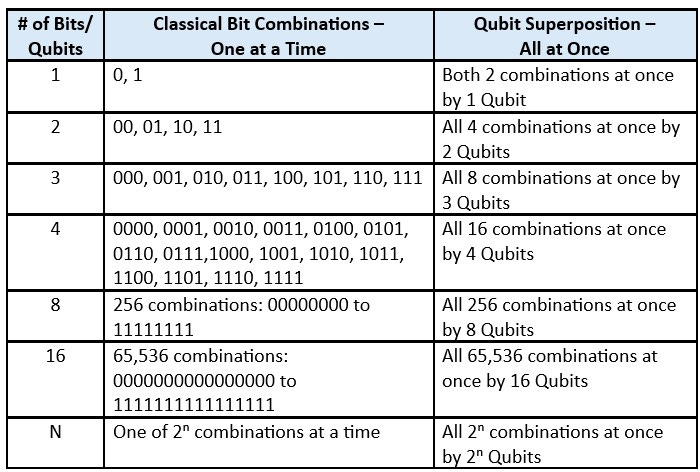Recently, Google has developed a quantum chip which it claims to solve a problem in just 5 minutes that would take a classical supercomputer 10 septillion or 1025 years to complete.
Let’s understand the statement deeply – especially how long is 10 septillion years exactly.
The age of earth is 4.5 billion years (4.5 × 10⁹) and the age of our universe is 13.8 billion years (1.38 × 10¹⁰). So, 10 septillion years is 7 × 1015 times longer than the age of the universe.
That means, if the entire age of our universe were squeezed into 1 second, then 10 septillion years would be 23 million years.
Simply mind-blowing!
Why quantum computation is so fast?
It’s because of their fundamental designs.
A Classical computer uses binary bits 0 or 1 – only one at a time. But Quantum computers use qubits, which can be 0/1 or both at the same time – due to a quantum property called superposition.
This means classical computers process one state at a time, while quantum computers can process many states simultaneously.
To understand better, look at the below table:
That’s how quantum computing can be exponentially faster compared to any traditional computer.
The fundamental Theory
Quantum computers harness the unique rules of quantum mechanics to process information in a radically different way. Instead of bits, they use qubits – tiny quantum systems like electrons or photons that behave as both particles and waves.
Because of their wave-like nature, qubits can exist in a superposition – meaning they can be in multiple states (0 and 1) at the same time, not just one or the other like classical bits. This allows quantum computers to explore many possible solutions simultaneously.
To keep this delicate quantum behavior stable, qubits are kept at ultra-cold temperatures, close to absolute zero (−273.15°C). At this point, thermal noise is minimal, and the quantum states are less likely to break down (a problem known as decoherence).
Quantum engineers then use precise energy pulses – such as microwaves or lasers to carefully control the qubits. By doing so, they perform calculations through a combination of superposition, entanglement, and quantum interference, allowing for powerful parallel computation that classical computers can’t match.
Why Businesses Need Quantum Computing
Quantum computing isn’t just faster – it can handle problems that are impossible for classical computers due to massive size and complexity. Here's how it's set to transform industries:
Breaking Through Classical Limits
The End of Moore’s Law: Transistors in classical chips are approaching atomic sizes, slowing down decades of progress. We're nearing the physical limits of classical scalability.
Large Scale Optimization Problems
Classical computers struggle with problems that grow exponentially — like optimizing global supply chains with billions of possible routes. Quantum systems can handle these far more efficiently.
Traveling Salesperson Problem (TSP): Finding the shortest route between 2,000 cities requires evaluating over 10^5,000 possibilities. Classical supercomputers cannot brute-force this in any practical time. Quantum algorithms can theoretically evaluate multiple routes simultaneously, making such problems feasible.
Finance: Real-time portfolio optimization, derivative pricing, and risk analysis are extremely complex and requires intensive computation. Quantum methods can provide near-instant insights.
Energy Efficiency
According to the International Energy Agency (IEA), data centres globally consume 1–2% of the world's electricity with a potential doubling by 2026 due to increasing demands from AI and cloud computing services. Quantum systems, by solving certain problems in fewer steps, could be vastly more energy-efficient for specific workloads.
Quantum Random Numbers
Classical computers, uses deterministic algorithms like Linear Congruential Generator (LCG) to generate pseudo-random numbers. However, quantum systems can produce truly random numbers using quantum algorithms – making cryptographic systems much more secure and resistant to prediction or attacks.
Searching Unstructured Data
Imagine you have a haystack with 1 million wooden needles, but only one is made of iron. With a classical computer, you'd pick up and check one needle one by one. In the worst case, you go through all 1 million to find the iron needle. So, the complexity is O(N).
Now imagine using a quantum magnet that pulls any iron needle. You wave it over the haystack, and instead of checking every needle, you find the iron one in just about 1,000 tries – the square root of 1 million. That’s O(√N).
For small problems, the speedup isn’t huge. But for huge databases – say, searching through 1 trillion entries – Grover’s Algorithm can reduce search time from 1 trillion steps to just 1 million.
Such algorithms can help in:
AI & Machine Learning: Quickly find optimal hyperparameters or best matches in large datasets.
Search Engines: Improve keyword or document matching in huge databases.
Fraud Detection: Rapidly identify suspicious patterns in financial transactions.
Accelerating AI & Machine Learning
Classical deep learning models can take days or weeks or months to train on large datasets. Quantum systems could cut this down drastically with quantum-enhanced linear algebra.
Some areas that can benefit from are:
Fraud detection across millions of transactions in real-time.
Facial recognition in smart cities.
Recommendation systems that can adapt faster to user behavior.
LLM, AI Agent, and AGI Models
Driving Scientific Discovery
Few notable areas are:
Drug Discovery: Simulating a single molecule like penicillin involves modeling quantum interactions between thousands of electrons — classically intractable. Quantum computers can simulate molecular behavior natively, potentially cutting years off drug development cycles.
DNA Synthesis & Protein Folding: Simulating how a long DNA or protein strand folds (crucial in drug design) can take months or years of supercomputing time. Quantum computers can model these interactions exponentially faster, accelerating biotech R&D.
Climate Modeling: Predicting climate systems involves trillions of variables — quantum methods can improve accuracy and speed, helping us respond to environmental challenges.
Green Chemistry: Quantum systems could design energy-efficient catalysts, replacing energy-intensive processes like the Haber-Bosch method, which consumes 1–2% of global energy to make fertilizer.
Challenges and Threats in Quantum Computing
While quantum computing holds enormous potential, it also faces several serious technical, economic, and security-related hurdles that must be addressed before widespread adoption.
Technical Immaturity
Quantum computers today are still highly error-prone. The delicate state of a qubit can collapse due to noise, vibrations, or even slight temperature fluctuations — a phenomenon known as decoherence. To build a single stable logical qubit, it may take thousands of physical qubits working together.
As of 2024, IBM’s most advanced system, Condor, has 1,121 qubits, but fully error-corrected systems will likely need millions.
High Infrastructure Costs
Quantum systems require extremely controlled environments, including cryogenic temperatures near absolute zero (−273°C), vibration isolation, electromagnetic shielding, and precision control hardware. Such requirements make quantum systems expensive to build and maintain.
IBM, Google, and Honeywell have collectively invested billions of dollars into quantum research and infrastructure. Only a handful of tech giants and research institutions can currently afford this.
Cybersecurity Risks
Quantum computing poses a direct threat to current cryptographic systems. Algorithms like RSA, ECC, and DSA are widely used today for secure communication – from banking transactions to government defense systems. These algorithms rely on mathematical problems (e.g., factoring large integers) that are hard for classical computers but easy for quantum machines using Shor’s Algorithm.
A powerful enough quantum computer could break 2048-bit RSA encryption in minutes to hours, exposing financial data, healthcare records, government secrets, intellectual property stored in cloud.
There's also a risk of ‘store now, decrypt later’ attacks. It means hackers are collecting encrypted data today, even if they can’t read it yet. They plan to decrypt it in the future using powerful quantum computers. This is a big risk for cyber-security once quantum tech is ready.
That’s why, in 2022, the U.S. government passed the Quantum Computing Cybersecurity Preparedness Act, pushing federal agencies to begin transitioning to quantum-safe encryption.
Talent Shortage
Quantum computing sits at the intersection of physics, math, engineering, and computer science. However, there are fewer quantum scientists and engineers globally with practical experience. A massive skills gap exists, with universities only recently introducing structured quantum programs. Until the workforce catches up, progress will remain limited to a small elite.
Ethical and Geopolitical Concerns
Access to quantum technologies is likely to be uneven, raising concerns about:
Technological Monopolies: Corporations or countries with early access could dominate sectors like finance, defence, and pharmaceuticals.
Global Inequality: Nations without the infrastructure or investment capital could be left behind, further widening digital divides.
Military Misuse: Quantum capabilities like cryptanalysis (breaking encryption) can spark a new form of tech arms race. A country with a large quantum computer could break into encrypted military communications of other nations.
Similarly, quantum sensors can detect submarines, stealth aircraft, or underground bunkers with extreme precision, even when traditional radar or sonar fails.
Access to quantum technologies is likely to be uneven, raising concerns about:
A nation with advanced quantum sensing could gain a huge intelligence edge, making current stealth technology obsolete.
Such kind of tech edge could shift global power dynamics – prompting nations to race to develop and control quantum capabilities, just like it happened with nuclear and AI.
Investment Timing Challenge
Quantum computing is promising — but not quite enterprise-ready. Most companies have already sunk serious investment into traditional AI including, cloud, GPUs, ML pipelines and they're seeing real returns now. Switching to quantum means big spending on new hardware and talent, with unclear short-term payoff.
For now, the smarter move is to maximize existing AI while keeping a close eye on quantum’s evolution.
Quantum Adoption Strategy
Jumping directly into quantum hardware isn't practical for most businesses today. Instead, a more realistic path is a hybrid approach — using classical systems alongside quantum-inspired techniques. This lets organizations benefit from quantum thinking without needing to invest heavily in complex infrastructure right away.
We’ve seen similar transitions before. Hybrid cars, for example, paved the way for fully electric vehicles.
Likewise, industries moved gradually from analog to digital systems to avoid disruption. Today, several companies like HPE, Mphasis, Infosys are applying quantum-inspired algorithms on classical machines to solve problems in areas like optimization and AI – gaining immediate value while preparing for future quantum integration.
When Will Quantum Computing Go Mainstream?
Quantum computing is still in its early stages but progressing steadily — much like classical computing did:
Transistor invented: 1947
Commercial CPUs emerge: 1970s (e.g., Intel 4004)
Widespread adoption: 1990s–2000s
Similarly, early development started around 2020s, and adoption is expected after a decade or two – who knows!
Big tech enterprises are investing in quantum now. Google aims to build a useful quantum computer by 2029. Microsoft Azure, Amazon, and IBM already offer cloud-based quantum access for developers and researchers.
Embracing the Quantum Future
Quantum computing is a game-changer – solving problems once thought impossible, from optimization and AI to cybersecurity and scientific breakthroughs.
However, the rise of quantum computing is a double-edged sword – it promises transformative power but also introduces unprecedented risks. Managing this transition will require global cooperation, forward-thinking policy, and investment in secure infrastructure.
Quantum adoption isn’t just plug-and-play. Businesses need a strategic, hybrid approach while the tech matures. The quantum era isn’t just a tech shift – it’s a competitive edge. Those who prepare now will lead tomorrow.
For most businesses, now is the time to explore quantum-inspired algorithms, build internal awareness, and develop long-term strategies – while quantum hardware continues to evolve.
The final question is: What’s your quantum strategy?



